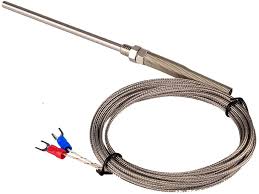Thermocouples are temperature sensors that measure temperature by utilizing the principle of the Seebeck effect, which generates a voltage at the junction of two dissimilar metals when exposed to a temperature gradient. Thermocouples are widely used for temperature measurement in various applications due to their ruggedness, fast response time, and wide temperature range capabilities. There are several types of thermocouples based on the combination of metals used for the junction:
1. Type K Thermocouple: Type K thermocouples are the most common and widely used thermocouples. They are composed of a positive leg made of chromel (an alloy of nickel and chromium) and a negative leg made of alumel (an alloy of nickel, aluminum, and silicon). Type K thermocouples are suitable for a wide temperature range from around -200°C to 1260°C.
2. Type J Thermocouple: Type J thermocouples consist of a positive leg made of iron and a negative leg made of constantan (an alloy of copper and nickel). They are commonly used in the range from -40°C to 750°C.
3. Type T Thermocouple: Type T thermocouples use a positive leg made of copper and a negative leg made of constantan. They are well-suited for low-temperature applications and have a range from -200°C to 350°C.
4. Type E Thermocouple: Type E thermocouples are composed of a positive leg made of chromel and a negative leg made of constantan. They offer good accuracy and are used in the range from -200°C to 900°C.
5. Type N Thermocouple: Type N thermocouples use a positive leg made of Nicrosil (an alloy of nickel, chromium, and silicon) and a negative leg made of Nisil (an alloy of nickel and silicon). They have a wide temperature range from -270°C to 1300°C.
6. Type B Thermocouple: Type B thermocouples are used in high-temperature applications. They consist of a positive leg made of platinum-rhodium alloy and a negative leg made of a platinum-rhodium alloy with a lower percentage of rhodium. Type B thermocouples have a range from 0°C to 1820°C.
Each type of thermocouple has specific characteristics and temperature ranges that make it suitable for different applications. The choice of thermocouple type depends on factors such as the required temperature range, accuracy requirements, environmental conditions, and the specific application’s demands.
